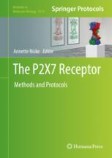Search
Search Results
-
Slack K+ channels limit kainic acid-induced seizure severity in mice by modulating neuronal excitability and firing
Mutations of the Na + -activated K + channel Slack ( KCNT1 ) are associated with terrible epilepsy syndromes that already begin in infancy. Here we report...

-
Protocol paper: kainic acid excitotoxicity-induced spinal cord injury paraplegia in Sprague–Dawley rats
BackgroundExcitotoxicity-induced in vivo injury models are vital to reflect the pathophysiological features of acute spinal cord injury (SCI) in...

-
A comparative study of the phenotype with kainic acid-induced seizure in DBA/2 mice from three different sources
The kainic acid-induced seizure mouse model is widely used in epilepsy research. In this study, we applied kainic acid to the subcutaneous injections...

-
Image-Based Quantitation of Kainic Acid-Induced Excitotoxicity as a Model of Neurodegeneration in Human iPSC-Derived Neurons
Excitotoxicity is a feature of many neurodegenerative diseases and acquired forms of neural injury that is characterized by disruption of neuronal...
-
Analyzing the Role of the P2X7 Receptor in Epilepsy
Purinergic signaling is increasingly recognized to play a role during the generation of hyperexcitable networks in the brain. Among the purinergic...
-
Intracerebroventricular Delivery of Human Umbilical Cord Mesenchymal Stem Cells as a Promising Therapy for Repairing the Spinal Cord Injury Induced by Kainic Acid
Spinal cord injury (SCI) is a common pathological condition that leads to permanent or temporal loss of motor and autonomic functions. Kainic acid...

-
MiR129-5p-loaded exosomes suppress seizure-associated neurodegeneration in status epilepticus model mice by inhibiting HMGB1/TLR4-mediated neuroinflammation
BackgroundNeuroinflammation contributes to both epileptogenesis and the associated neurodegeneration, so regulation of inflammatory signaling is a...

-
Cell-specific extracellular vesicle-encapsulated exogenous GABA controls seizures in epilepsy
BackgroundEpilepsy affects ∼60 million people worldwide. Most antiseizure medications in the market act on voltage-gated sodium or calcium channels,...

-
Agrin-Lrp4 pathway in hippocampal astrocytes restrains development of temporal lobe epilepsy through adenosine signaling
BackgroundHuman patients often experience an episode of serious seizure activity, such as status epilepticus (SE), prior to the onset of temporal...

-
Deletion of the autism-related gene Chd8 alters activity-dependent transcriptional responses in mouse postmitotic neurons
CHD8 encodes chromodomain helicase DNA-binding protein 8 and its mutation is a highly penetrant risk factor for autism spectrum disorder (ASD). CHD8...

-
Pharmacological and therapeutic applications of Sinapic acid—an updated review
Phenolic compounds, present in plants, are considered to be indispensable parts of human dietary sources. Sinapic acid, is a natural herbal compound...

-
Photobiomodulation improves the synapses and cognitive function and ameliorates epileptic seizure by inhibiting downregulation of Nlgn3
BackgroundTemporal lobe epilepsy (TLE) remains one of the most drug-resistant focal epilepsies. Glutamate excitotoxicity and neuroinflammation which...

-
Nrf2 is predominantly expressed in hippocampal neurons in a rat model of temporal lobe epilepsy
BackgroundDrug resistance is a particular problem in patients with temporal lobe epilepsy, where seizures originate mainly from the hippocampus. Many...

-
Neuregulin 1/ErbB4 signaling contributes to the anti-epileptic effects of the ketogenic diet
BackgroundThe ketogenic diet (KD) has been recognized as a potentially effective therapy to treat neuropsychiatric diseases, including epilepsy....

-
Identification of ferroptosis-related genes in acute phase of temporal lobe epilepsy based on bioinformatic analysis
BackgroundEpilepsy is a prevalent neurological disorder, and while its precise mechanism remains elusive, a connection to ferroptosis has been...

-
Calcium-permeable AMPA and kainate receptors of GABAergic neurons
This Commentary presents a brief discussion of the action of glutamate calcium permeable receptors present with neurons on the release of the...

-
PLPP/CIN-mediated NF2-serine 10 dephosphorylation regulates F-actin stability and Mdm2 degradation in an activity-dependent manner
Neurofibromin 2 (NF2, also known as merlin) is a tumor suppressor protein encoded by the neurofibromatosis type 2 gene NF2 . NF2 is also an...

-
Fine map** and candidate gene analysis of Dravet syndrome modifier loci on mouse chromosomes 7 and 8
Dravet syndrome is a developmental and epileptic encephalopathy (DEE) characterized by intractable seizures, comorbidities related to developmental,...

-
Advances in Fe(II)/2-ketoglutarate-dependent dioxygenase-mediated C–H bond oxidation for regioselective and stereoselective hydroxyl amino acid synthesis: from structural insights into practical applications
The asymmetric hydroxylation of inactive carbon atoms in organic compounds remains an important reaction in the industrial synthesis of valuable...

-
T-Type Calcium Channels in Epilepsy
Epilepsy is a complex neurological disorder commonly thought to involve hyperexcitable neurons that recruit neuronal populations within circuits to...
